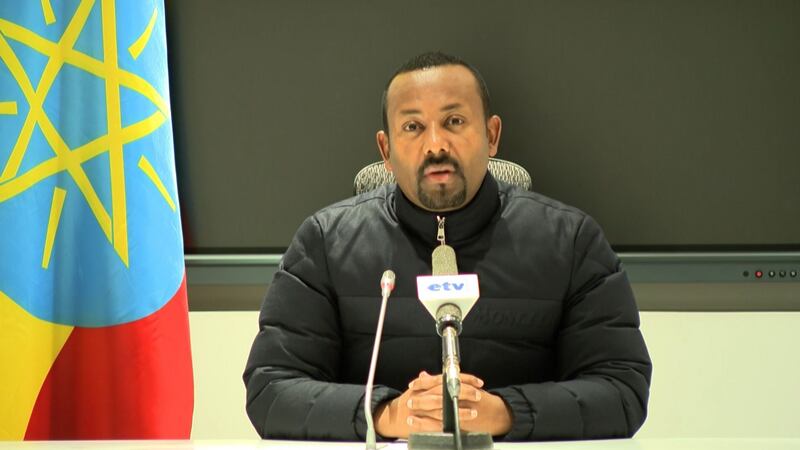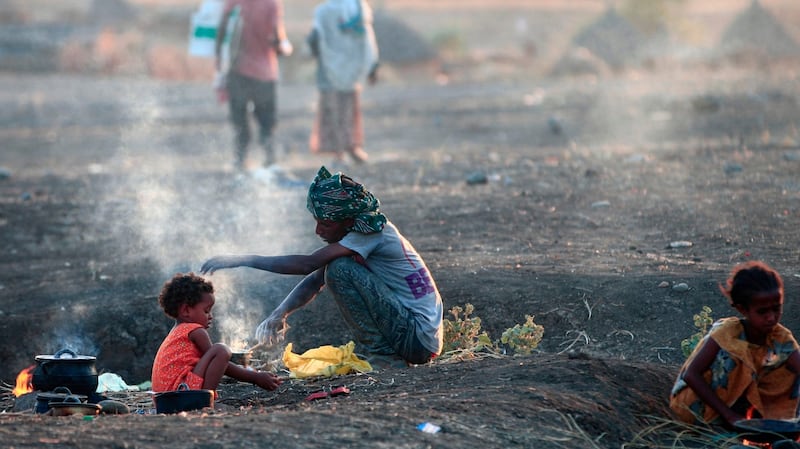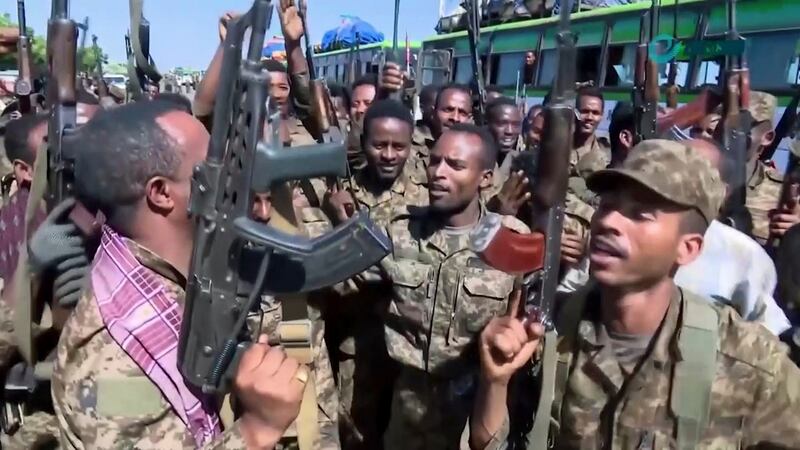Gashaw Koye, a 42-year-old farmer from Amhara dressed in crisp new battle fatigues, met his wife from the neighbouring region of Tigray more than two decades ago. Now, as part of an army mustered by Abiy Ahmed, Ethiopia's prime minister, he is preparing to fight Tigray's regional government.
It is bad enough that Gashaw may have to battle people from his former wife's northern homeland. Worse, among the soldiers fighting for the Tigray People's Liberation Front, or TPLF, is the couple's 21-year-old son, Amanuel.
There is little love lost between the regions of Amhara and Tigray, which have long-running land disputes along their shared border. That animosity is now part of a broader national conflict in Ethiopia, a country of 110 million people in the Horn of Africa.
“I am going to have to fight the terrorists of the TPLF for the good of Ethiopia,” says Gashaw, referring to the regional party that ran the country for almost three decades but is now considered by some to be a rogue force. “This means I may have to fight my own son.”
He is speaking as dozens of militiamen like him, most brandishing AK-47 rifles, clamber aboard buses and trucks in the city of Gondar, to be transported across the border to Tigray.
“This is what Ethiopia has become,” says Gashaw, stroking his own well-worn rifle. “A big political mess that makes fathers fight sons.”
The political crisis that has set Ethiopian against Ethiopian began in the early hours of November 4th when Abiy launched what he called “a law enforcement” operation – replete with air strikes and a ground troops operation – against the TPLF.
The prime minister, an army intelligence officer when the TPLF was running the country, said he was left with no choice after the Northern Command of the federal defence forces based in the Tigrayan capital of Mekelle were attacked “when they were at their most vulnerable, in their pyjamas”.

With the eyes of the world focused on the US election, Ethiopian forces bombed arms depots and other targets in Tigray. The army, together with militias and regional special forces, began a ground attack that Abiy says has already “liberated” large parts of Tigray from the TPLF.
Missiles
The conflict has quickly spread. On Saturday, the TPLF slammed rockets into Asmara, capital of Eritrea, a neighbouring country, after accusing the secretive state, which broke away from Ethiopia in the early 1990s, of siding with Abiy. The TPLF has also fired missiles at the airport in Amhara's capital, Bahir Dar, and at Gashaw's home town of Gondar.
This is the gravest crisis of Abiy’s tumultuous 2½-year premiership – one that has already included the award of a Nobel Peace Prize for concluding a peace deal with Eritrea, an assassination attempt and an attempted coup. It threatens to scupper any chance of credible democratic elections next year, which had already been made harder by the arrest of senior opposition figures.
The fear is that war in Tigray could trigger a humanitarian crisis and widespread ethnic and political violence in a country that, although deeply divided, had been regarded by many as a model of economic progress in Africa.
Some even fear that it could precipitate a Yugoslavia-style break-up of Ethiopia along ethnic lines. The country, with a history of independent states stretching back three millennia, is divided into 10 ethnically defined regions, each with their own distinct language, culture and history.
"There are eerie similarities with Yugoslavia, except Yugoslavia imploded," says Payton Knopf, senior adviser to the Africa programme at the United States Institute of Peace. "If you do see fragmentation in Ethiopia ... it won't just collapse in on itself, but it will become a black hole that draws in all of its neighbours."
As well as the bombing of Eritrea, there are already signs that the conflict – just two weeks old –is having a regional impact. More than 30,000 refugees have fled into Sudan, a fragile state ill-equipped to cope with a sudden influx of people. If the conflict persists, the UN warns that tens of thousands more could follow.

Leaders of the African Union and other international organisations have called for an immediate ceasefire and dialogue. That doesn't look likely for now as different sides in the conflict dig into entrenched and seemingly irreconcilable positions. As in most wars, truth – or at least verifiable truth – has been the first casualty, especially on social media where misinformation and hate speech was already rife.
To Abiy’s supporters, the federal government has been pushed to its limit by the TPLF which, ever since losing power three years ago, has, they say, been spoiling for a fight. Abiy accused the TPLF of defying central authority by holding regional elections in September after a national poll – in which he would have faced the electorate – was postponed until next year because of the coronavirus pandemic.
The final straw, said Abiy, was reached at 10pm on November 3rd when the TPLF attacked the Northern Command stationed in Mekelle. The government reported deaths on both sides. “Such a treasonous act left us no option but to mobilise our law enforcement and defence machinery in an operation intended to end the prevailing lawlessness in the region,” Abiy said.
Abiy has since blamed the TPLF for the killing of hundreds of civilians in a gruesome attack, reported by Amnesty International last week, in which mainly non-Tigrayans were stabbed and hacked to death in the Tigrayan town of Mai Kadra. The massacre fits a pattern, the government said, of TPLF-sponsored violence targeting other ethnic groups.
The TPLF and its supporters dismiss such accounts as propaganda intended to demonise the party and justify war. Ezekiel Gebissa, an ethnic Oromo who advocates strong regional rights and is assistant professor of history at Kettering University in Michigan, says Abiy had been moving army divisions towards Tigray for weeks in preparation for an attack.
Pressure
The fear is that ethnic violence, regardless of who is responsible, could provoke tit-for-tat killings around the country. On Sunday, the Ethiopian Human Rights Commission said an attack on bus passengers in Benishangul-Gumuz, one of the country’s 10 regions, had left at least 34 people dead. Human Rights Watch warned that rhetoric against the TPLF was taking on a potentially dangerous anti-Tigrayan tinge.
The federal parliament has ratcheted up pressure on Tigray’s government by issuing arrest warrants against dozens of members of the TPLF leadership “for endangering the country’s existence”.
To his critics, blame for the violence now convulsing the country lies with Abiy. The crisis, they say, has been fed by his attempt to amass too much power at the centre in defiance of a federalist constitution that devolves authority to ethnically constituted regions.
“Abiy wants to unify Ethiopia under his medemer philosophy,” says Prof Gebissa, referring to the prime minister’s use of an Amharic word signifying strength through diversity to define his pan-Ethiopian vision. “But medemer simply means assimilation and the flattening of identity into one. Anyone who stands in Abiy’s way is his enemy.”

Ethiopia has been drifting towards conflict for months, if not years. At the heart of this crisis – one of several regional disputes in the country – is the position of the TPLF in national politics. Last year, it refused to join Abiy's newly established Prosperity party, a non-ethnic organisation based on his medemer doctrine.
Loss of power has come as a shock to the TPLF, which ran the country for 27 years following its lead role in the overthrow of the hated Marxist Derg regime in 1991. Although Tigray’s five million people make up only 6 per cent of Ethiopia’s population, the TPLF became the dominant force in a national four-party coalition known as the Ethiopian People’s Revolutionary Democratic Front.
Under Meles Zenawi, a brilliant strategist and prime minister from 1995 until his sudden death in 2012, the EPRDF embarked on an Asian-style development drive modelled loosely on South Korea. Once a byword for famine, the country began to make palpable progress, both in terms of economic growth as well as in health, education and infrastructure.
Though the TPLF was deeply authoritarian, it won many international plaudits. Dani Rodrik, professor of economics at Harvard University, says Meles's effort to transform Ethiopia from a poverty-stricken peasant economy into a middle-income country scored real successes.
"Back then, if you were to tell the IMF and World Bank that your growth model was going to be ramping up public investment from low single-digits to 20 per cent of gross domestic product and to get [annual] 10 per cent growth, they'd have said you were totally crazy," says Rodrik of the country's state-led model. "Yet they did just that for two decades."
Politically, however, the experiment was unsustainable. Domination of the federal government by Tigrayans bred resentment. The government operated a police state in which neighbours spied on neighbours, both to further the government’s development goals – such as use of prescribed fertiliser or participation in vaccination campaigns – as well as to report on unauthorised political activity.
Protesters
After Meles’s death in 2012, the system began to crumble. Mass street protests erupted in Oromia, which has long felt marginalised from power even though its people make up more than one-third of Ethiopia’s population. Unusually, Oromo protesters joined forces with those from Amhara, the traditional seat of Ethiopian power, which also felt bitterly towards TPLF rule. In the ensuing years, security forces shot thousands of protesters and imprisoned and exiled thousands more.
The government’s solution to the crisis was to appoint a new prime minister. In April 2018, over TPLF objections, it selected Abiy, an Oromo son of a Muslim father and a Christian mother and a fluent speaker of Amharic, Oromo and Tigrinya, the languages of Ethiopia’s three largest ethnic groups. (There are 80 in all.)
The hope was that Abiy’s appointment could ease tensions, particularly in Oromia. At first it appeared to work. Brandishing a liberal-sounding agenda, he released political prisoners, invited back those who had gone into exile and concluded peace with Eritrea. The countries had fought a bitter war between 1998 and 2000.
But Abiy also purged Tigrayans from government and the security service and led a crackdown on corruption that members of the TPLF old guard saw as targeted against them. Although he had been part of the old regime, he labelled the era of TPLF control as “27 years of darkness”.
Worku Adamu, a senior member of Abiy's Prosperity party, says the TPLF is mourning its loss of power: "For 27 years, the TPLF controlled the whole system and the new government captured this power."
Belete Molla, chairman of the National Movement of Amhara, also regards the TPLF as the villain of the piece. He blames Abiy not for waging war on Tigray, but for failing to do so sooner. "This is what he should have done two years back. The TPLF has always been a mafia group," says Belete, accusing it of "orchestrating massacres across Ethiopia".
Debretsion Gebremichael, chairman of the TPLF, denies any such activity, laying the blame for the crisis squarely with Abiy. "He is a dictator, a complete dictator," he said on a telephone call from Tigray last week after federal forces attacked. "Abiy pretended to be a reformer and a democrat, but deep inside he was planning to be a king."

Debretsion accuses the prime minister of colluding with Isaias Afewerki, Eritrea's authoritarian leader, whose troops he said had already infiltrated Tigray. If the fighting continues, Debretsion says, he does not see how Ethiopia can remain intact. "If these people don't come to their senses, break-up will be a natural consequence of this kind of fighting," he added.
National identity
Abiy has defended action in Tigray as a restoration of law and order and rejects the description of the conflict as a civil war. More broadly, say his supporters, he is trying to create a unified national identity, in which ethnicity recedes in importance and a new sense of national citizenry takes hold. "National unity is a priority, nation building is a priority," says Billene Seyoum, Mr Abiy's spokeswoman.
“Ethnic entrepreneurs [those seeking to manufacture unrest] want to keep dividing this country forever,” says another close aide of the prime minister. “Ethnicity is being used by these people as a political weapon.”
Elsewhere in Ethiopia, Abiy faces calls for separation among ethnic groups in the south as well as violence in parts of Oromia. Senior Oromo opposition leaders, including Jawar Mohammed, have been arrested.
For the moment, Abiy is concentrating on Tigray where, he says, the operation can be wrapped up quickly. But most experts fear conflict will drag on as experienced and well-armed TPLF fighters dig in.
“It is not clear that Abiy’s forces have a military advantage going into this war. The TPLF is not a rag-tag band of guerrillas,” says Knopf of the US Institute of Peace. “Even if somehow they are able to hunt down the whole Tigrayan leadership, how are you going to subjugate the Tigrayan population?” he asks. “I don’t see where this is supposed to end.”
Back in Gondar, from where Gashaw set off to fight, Aba Gebremichael, an Orthodox Christian monk, is praying for peace. As militias, special forces, and Ethiopian army troops pack the streets outside his 17th-century stone church, he points his cane at a fresco of the devil on the church’s magnificently painted interior.
“War is an evil thing. It makes brothers fight brothers and fathers fight sons,” says Father Aba, shaking his head at the prospect of bloodshed. “And we have seen too much of that in Ethiopia already.” – Copyright The Financial Times Limited 2020











